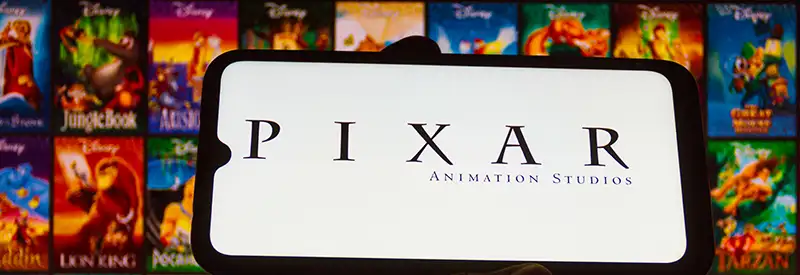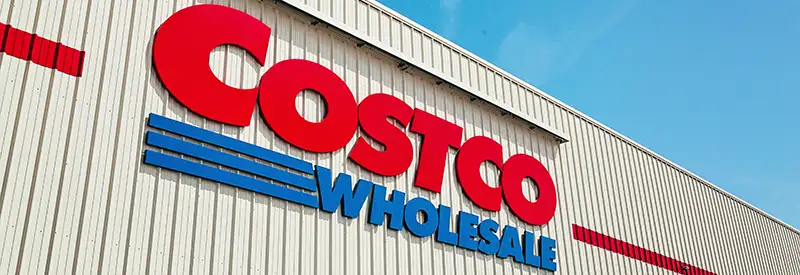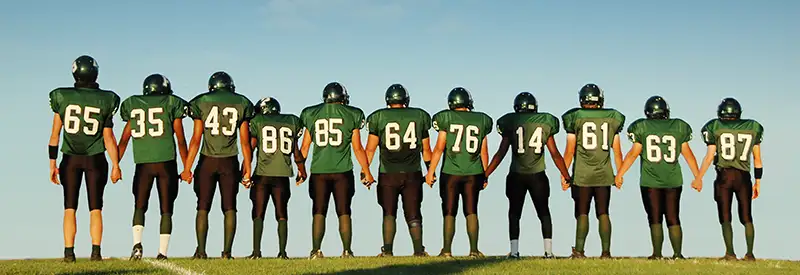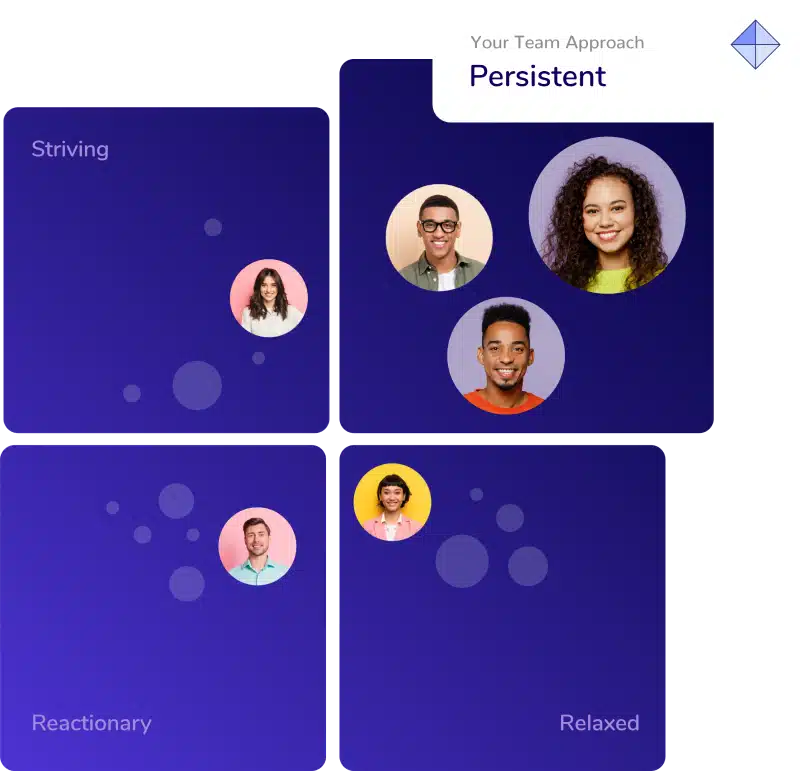
Explore 10 examples of team dynamics in action, and learn how their underlying principles can help you strengthen your own team.
Intro to Team Dynamics
There’s a reason “plays well with others” has long been considered high praise from teachers.
Being able to cooperate and collaborate is as important in a work environment as it is on the playground. The measurement of how well individuals relate to one another while working together is known as team dynamics.
According to research from Deloitte:
- 73% of employees feel they do better work as part of a team than on their own
- 60% believe they’re more innovative when working with others
- 56% feel more satisfied while working with a team
However, team effectiveness requires more than gathering a few of your best and brightest employees, handing them a brief, and waiting for the magic to happen.
In almost all instances, positive team dynamics have to be cultivated.
Below, we look at the factors that influence group dynamics, examples of effective team dynamics, and how you can actively boost your team’s effectiveness.
In this blog, we cover:
What are Team Dynamics
Team dynamics refers to the behavioral and interpersonal forces that shape the way teams interact, communicate, and collaborate. Strong dynamics promote cohesion and effectiveness, while poor dynamics may lead to poor communication, conflict, and misalignment.
In a nutshell, team dynamics describes how members of a group behave and interact while working toward a common goal. Open communication, mutual respect, and a willingness to put “we” ahead of “me” are a few essential requirements of a healthy, productive team.
To understand just how important healthy team dynamics are, simply consider the consequences of when team dynamics break down.
A major reason for their disappointing results? Chaotic team dynamics.
Egos clashed, communication broke down, and the team lacked any unity. All these factors — grandstanding, refusal to consider alternative viewpoints, and allowing personality conflicts to hinder work — are signs of unhealthy team dynamics. Given that working collaboratively in teams can boost productivity by 50%, organizations can’t afford unhealthy or unproductive teams.
It’s also important to distinguish between team dynamics and group dynamics. Team dynamics focus on how individuals intentionally work together to achieve a shared goal, while group dynamics encompass broader social, psychological, and behavioral forces that shape interactions within any collection of people — whether or not they share a purpose. A group might simply be people gathered in the same setting who don’t necessarily know each other or work together.
Factors that Affect Team Dynamics
Several key factors determine the health and productivity of your team’s dynamics. Shortcomings in just one area can make the difference between a group that smashes its goals and one that falls short while straining your work environment and culture.
Communication
Open Communication
Open communication creates healthy, thriving team dynamics, in which all members share ideas, updates, and concerns.
Closed Communication
Closed communication occurs when only one person is actively communicating, such as a flight attendant explaining the safety features of an aircraft prior to takeoff. While certain situations require the efficiency of closed communication to impart essential information, closed communication doesn’t encourage collaboration or the sense of belonging necessary for healthy team dynamics.
Closed-loop Communication
Closed-loop communication helps prevent misinterpretations and other errors. For instance, after brainstorming, a team member might read back the accepted ideas. Members would volunteer for or be assigned follow-up actions, and each participant would reiterate what they’d be doing next. Any misunderstandings would be clarified at that time, improving efficiency while maintaining the collaborative benefits of open communication and bolstering the team’s cohesiveness.
Leadership Style
Autocratic Leadership
Autocratic leadership is often associated with closed communication. Autocratic team leaders typically make decisions with little to no input from other team members. While in a crisis, an autocratic approach might be necessary to yield immediate results, this leadership style does not foster collaborative team dynamics over the long run.
Democratic Leadership
Democratic leadership is more synonymous with productive team dynamics. A democratic leader champions feedback. And because their insights are valued, team members are more apt to participate and take ownership, resulting in greater team effectiveness, creativity, and innovation as well as higher personal and job satisfaction for each participant.
Transformative Leadership
Transformative leadership style falls somewhat between autocratic and democratic leadership. Here, the team leader’s priority is motivating team members to excel and effect significant change. Like democratic leaders, transformative ones will applaud feedback, but they might not elicit it as actively. Like an autocrat, a transformative leader might make certain decisions without seeking consensus. Above all, a transformative leader emphasizes team dynamics focused on innovation and adaptability, promoting collaboration while also providing individualized guidance to team members.
Laissez-faire Leadership
Laissez-faire leadership resembles a lack of leadership altogether. Here, the team leader trusts group members to make their own decisions and do their best work with minimal input or oversight. This can lead to enhanced creativity but less collaborative team dynamics, and self-motivated members are critical to its success.
In fact, certain situations might require team leaders to modify their style. However, defaulting to, say, a laissez-faire style when members require inspirational, transformative leadership can weaken team dynamics. Likewise, assuming a democratic leadership style could generate greater engagement and innovation within a previously unmotivated, uncommunicative team.
Team Roles
Well-defined team roles strengthen team dynamics. Each member needs to understand their responsibilities and expectations to perform effectively, and employees who are fully aware of what they are accountable for are more likely to take pride in a job well done.
What’s more, when each team member understands the roles of the others in their group, they know who to call upon for certain tasks. On the flip side, poorly defined roles can lead to inefficiencies, with group members inadvertently duplicating efforts or leaving tasks unfinished.
Clearly defined roles should still allow for flexibility. Team members should be able to work beyond their roles and offer constructive feedback. Not only does this promote innovation and more collaborative, engaged team dynamics, but it also allows group members to gain new proficiencies that will ultimately strengthen not just the team but the company.
Team Composition
A group made up solely of A-type, take-charge personalities might spend more time arguing about who’s right than taking action. A team composed only of passive, unassertive types might also fail to act, as nobody would be eager to volunteer solutions or make decisions.
It’s the well-rounded diversity of group members that puts the dynamic into team dynamics. The most effective teams encompass complementary personality types, strengths, weaknesses, viewpoints, and areas of expertise.
That said, such diversity can also lead to clashing opinions, communication styles, and work methodologies. Preventing clashes requires well-defined team roles, clear communication, and a team leader sensitive to conflict.
Team Culture
Regardless of a group’s makeup, a cohesive, positive team culture is essential. All team members should work toward common goals, feel empowered to adapt and learn, be encouraged to contribute beyond their immediate team roles, and share a mutual respect for one another. Add in a team leader with solid conflict resolution skills, well-defined individual and group expectations, and effective communication channels, and you have an enviable team culture in which productive, healthy team dynamics can flourish.
These are also key elements that contribute to psychological safety, a cornerstone of healthy team dynamics. Psychological safety allows individuals to take interpersonal and professional risks — such as speaking up, admitting mistakes, asking questions, or offering new ideas — without fear of judgment or reprisal. When this safety is present, teams deepen their trust and mutual respect, become more productive, and are better equipped to uncover novel solutions to business problems.
10 Examples of Effective Team Dynamics
So far, we’ve been focused largely on theoreticals. Below are concrete examples of powerful team dynamics in action.
1. Conflict resolution at Pixar

Conflict is inevitable in a modern work environment, particularly among teams with multiple personality types. But while differing views can create tension, there are specific strategies you can use to channel conflict and create better outcomes altogether.
At Pixar, for example, conflict isn’t avoided. It’s structured.
One of the studio’s most well-known feedback tools is called “plussing,” a technique adapted from improv, which accepts all ideas rather than rejecting them outright and counters with “yes, and…”
Pixar also employs principles of negotiation, like explicitly separating people from the problem. These techniques help create a safe space for disagreement, where diverse perspectives can push ideas further rather than shut them down.
2. Collaborative problem-solving at NASA

Modern business may not involve life-or-death decisions, but the results of focused collaboration are powerful — and the consequences of misalignment can be costly. NASA’s Apollo 13 mission is a textbook example of the power of collaborative problem-solving.
Two days into the spacecraft’s journey to the moon, an oxygen tank exploded and disabled its electrical and life-support systems.
The three astronauts onboard and Mission Control on the ground worked together to alter the craft’s course, which required additional collaboration with technicians to write new computer software.
In addition, engineers on the ground devised a way to resolve another problem: the removal of carbon dioxide. After coming up with a solution, the engineers instructed the astronauts on how to implement it. Apollo 13 commander Jim Lovell later described this life-saving solution as “a fine example of cooperation between ground and space."
3. Cross-functional collaboration at Apple

The iPhone might not be the icon of innovation it is today if it were not for cross-functional collaboration. In addition to hardware and software engineers, designers and marketers were involved from the early stages.
The same cross-functional collaboration produced the iPhone’s myriad upgrades. For instance, several dozen teams, from video engineering to silicon design, contributed to the development of its dual-lens camera with portrait mode.
4. Organizational agility during COVID

Especially in the age of AI, change is a constant. But the most agile teams can pivot quickly without losing momentum. We already know this is possible — because we’ve seen it happen.
When the pandemic started, organizations transitioned from working in offices to working from home virtually overnight. IT teams quickly established VPNs and enabled remote-meeting software. HR departments developed new procedures and protocols. Marketing teams went into crisis-management mode to communicate effectively with clients and customers. Companies with strong team cultures and group dynamics had minimal disruption to their daily operations compared to other organizations that weren’t as collaborative or agile.
5. Accountability at Starbucks

Strong team dynamics rely on leaders who take responsibility, even when things go wrong.
When Howard Schultz returned to his position as Starbucks CEO in 2008, the company’s operating income, customer traffic, and stock price went tumbling. One of his first actions: “We stood up in front of the entire company as leaders and made almost a confession—that the leadership had failed the 180,000 Starbucks people and their families,” he told Harvard Business Review. “And even though I wasn’t the CEO, I had been around as chairman. I should have known more. I am responsible. We had to admit to ourselves and to the people of this company that we owned the mistakes that were made.” His accountability demonstrated an openness and transparency that created trust among team members going forward.
6. Clear communication at Slack

Clear, open communication in a work environment goes beyond using closed-loop communication methods and encouraging input from team members. It also requires using multiple communication channels, such as email, project management platforms, and one-on-one direct messaging as appropriate.
Slack is a great example of this type of proactive communication. It uses its own platform to share important information via public channels. Employees can ask clarifying questions or offer feedback directly in threaded discussions. This helps keep everyone on the same page and avoid the potentially damaging consequences of miscommunication.
7. Leadership influence at Microsoft

Just as clear communication involves more than blunt clarity, leadership influence extends beyond choosing a leadership style. It includes modeling specific behaviors and offering support. The latter is especially important and, sometimes, challenging, given the inevitable variances in work and personality styles among team members.
When Satya Nadella became CEO of Microsoft in 2014, the company was plagued by internal rivalries and stagnation. Nadella shifted the culture by modeling collaboration and empathy. He hosted internal listening tours, redefined leadership KPIs to include team mentorship, and made empathy a core value in product and team design. His leadership had a ripple effect that went on to reignite innovation and make Microsoft one of the top global workplaces.
8. Supportive environments at Costco

Psychological safety is a requisite for thriving teams. Costco consistently pops up as an example of a supportive work environment. Its global Costco Connects program hosts gatherings of no more than 15 employees at a time, facilitated by managers using a comprehensive toolkit, where participants share challenges and offer suggestions.
An impressive 144,000 employees — nearly half of Costco’s workforce — have participated to date, and managers have implemented workplace changes where appropriate as well as provided mental health and other resources.
The company also strives to offer employees two consecutive days off each week, a rarity in retail, and prioritizes internal promotions. Coupled with wages and benefits far above average for retail, this supportive environment has led to low turnover rates and exceptional team performance.
9. Positive feedback loops at Costco

Feedback loops are essential not just for employee satisfaction but also for practical and tangible improvements to business operations. The Costco Connects campaign is also an example of a positive feedback loop: The company or team leader solicits feedback from employees (or customers), reviews the input, implements relevant improvements, then analyzes the results and solicits additional feedback.
10. Well-defined roles in sports

You need only look at a football team to understand the importance of well-defined roles. Every player, from the quarterback to wide receiver, knows their responsibilities and how they contribute to the team’s goal. There’s clarity and coordinated effort. High-performing business teams mirror this structure with clearly defined roles as they pursue a common goal.
How to Improve Team Dynamics
Team dynamics aren’t immutable — which is good news for everyone whose work environment suffers from disengaged employees, uncooperativeness, or poor communication. There are multiple ways you can improve group dynamics and team effectiveness. Here’s how:
Define and periodically review team goals and roles
Goals change, roles evolve, and the business transforms. However, team members are often left unclear about how these changes affect them. Some workers might also be unaware of other team members’ roles or responsibilities. Regularly defining — and when necessary, redefining — roles and establishing measurable individual and team goals helps ensure that everyone’s work is aligned with the same objectives while promoting a team culture of cooperation.
A good solution is the RACI model, a framework that can help you define and clarify roles and responsibilities within teams. RACI ensures everyone involved in a task or project understands their role, who needs to be consulted or informed, and who has ultimate decision-making power. RACI is an acronym that stands for:
- Responsible: The person who will do the work or complete the task/project.
- Accountable: The stakeholder who is ultimately answerable for the work.
- Consulted: Team members whose input and opinions need to be gathered before completing a project.
- Informed: The Stakeholders who need to be updated throughout the work but who may not be directly involved.
Break down communication barriers
Encourage team members to offer both constructive feedback and praise when appropriate. Don’t limit this to brainstorming sessions, quarterly status updates, or annual reviews. Consider surveys if certain members don’t feel comfortable speaking up in front of peers, and make use of collaborative platforms. Above all, listen actively and empathetically, and emphasize that there are no bad ideas. Open communication and trust go hand in hand. Both set the foundation for team effectiveness.
Inspire continuous improvement
Another benefit of open communication and constructive feedback is that they foster a work environment that values continuous improvement. Continuous improvement also includes upskilling, ongoing education, and experimentation. Investing in employees not only strengthens the team but also bolsters engagement and cooperation.
Introduce team-building exercises
Before implementing team-building activities, it’s important to determine your objectives: Do you want to improve communication among team members? Introduce newcomers to the group? Enhance collaboration? Redefine team goals?
Your goals should determine which activities or games you include. For example, “Two truths and a lie” helps members get to know each other, whereas dividing the group into smaller teams for a scavenger hunt focuses more on collaboration and problem-solving.
Start using Wonderlic Team Dynamics
One of the most effective ways you can strengthen team dynamics is with objective data that uses the latest industrial-organizational psychology. Wonderlic Team Dynamics, part of Wonderlic Develop, is an employee development tool that gives team leaders and individuals an understanding of the communication styles, motivators, aptitudes, strengths, and weaknesses of every team member. Just as important, its science-based insights offer specific tactics for getting the best out of every member, individually and as a whole. Employees can use the tool as well for self-development in their roles, and managers can use it for their roles and to build well-balanced, high-performing teams.

Build a Stronger Team Today
Great teams aren’t created by accident. A team with complementary strengths and weaknesses and well-defined roles is almost certain to achieve greater results than a disengaged, homogenous team unwilling or unable to collaborate. This is even truer for teams with a responsive leader who prioritizes open communication and a culture of cooperation.
The fruits of healthy team dynamics include accountability, agility, skillful conflict resolution, and collaborative problem-solving — all of which are necessary for the continued growth and success of your organization.
Interested in building a stronger team with the latest industrial-organizational psychology? Schedule a Wonderlic demo today.
Weekly insights to hire smarter






